This title is so great to us, it has to be put in to categories, Best Game Ever and Games You Slept On.
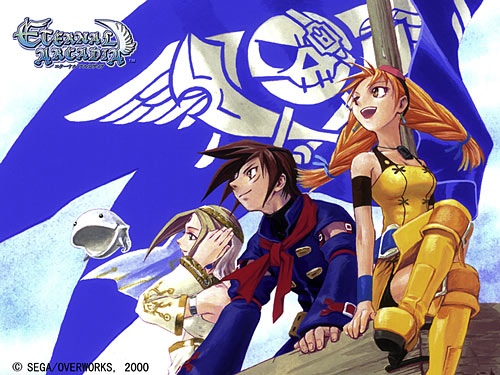
During its brief lifespan, the Sega Dreamcast was hardly known as a system for RPG enthusiasts. And yet, it managed to bring to the table one of the most satisfying RPG experiences of the era, a mix of solid gameplay, colorful characters, harmonious music and pirates. The game in question: Skies of Arcadia. And while it never achieved the status of super-hit, it did influence a generation of gamers and games who continue to recall it with fond memories (and the occasional cosplay).
 Skies of Arcadia was something of a dark horse game on a dark horse system. It was one of only three “real” RPGs on the Dreamcast (the other being the grind-fest “Evolution” and the landmark “Grandia II”). And yet, it managed to set itself apart from the others through a series of twists and turns that were unique at the time, but which would lay the groundwork for many subsequent games.
Skies of Arcadia was something of a dark horse game on a dark horse system. It was one of only three “real” RPGs on the Dreamcast (the other being the grind-fest “Evolution” and the landmark “Grandia II”). And yet, it managed to set itself apart from the others through a series of twists and turns that were unique at the time, but which would lay the groundwork for many subsequent games.
The story revolved around three characters: Sky-Pirate Vyse; his best friend, the bubbly Aika; and mysterious magical girl Fina. Their relationship was developed strongly over the 40 plus hours of gameplay. It never went down the romance path (at least not as much as many other games would have), and was focused more on the idea that three people could save the world if they tried hard enough.
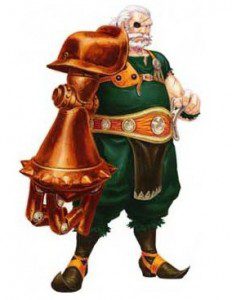
Well, more like four people. During the course of the game, the fourth character slot revolved between two more colorful folk: the grizzled “sea captain” Drachma and the urbane Prince Enrique, of the Valua Empire. Unlike the “main three,” these two additions were more cookie cutter: Drachma, a cross between Ahab and Cid Highwind, “swore” a lot and obsessed over a whale he needed to hunt, while Enrique was the stereotypical disillusioned son of a despotic tyrant who joined the Pirates because he loved the freedom, and hated the hypocrisy. While both played roles in the story, and indeed were necessary for progressing forward, they never exactly enjoyed the same amount of exposition as the “big three.”
The plot focused on the efforts of the Valuan Empire to revive these things known as “Gigas,” which were collossi of the ancient world that had great destructive power, yada yada yada. Fina was the last survivor of an ancient race sworn to protect the gigas from being used by vile…etc, etc etc. You’ve heard it before. Evil empire seeks great power, small band of rebels resist them. The small band has the “heart” to succeed, and they topple their foe, save the world, get the girl, happily ever after. The story itself was fairly straightforward, with few side quests, and was nothing really new. What made Skies of Arcadia such a wonderful game was what you could DO in the world while you were progressing along the main story. The world was a character, and it made the experience so much more validating in the end.
First off, it should be noted that Skies of Arcadia was one of the most beautiful RPGs ever made (and not just at the time). The developers put painstaking attention in crafting a flawless, visually stunning world that almost leapt off the screen at the player. Vivid colors, subtle sounds, intricately designed dungeons and towns, these all contributed to making the game lovely to look at. The “bestiary” was just as unique and varied, with nary a copy of anything to be found. Enemies were unique to their own worlds, and reflected the designs therein. The Pirates of the Blue Rogues were colorful and rough, the empire was silver, stoic and sharp. Despite being technologically “inferior” to the Playstation 2, the graphics on the Dreamcast were among the best gaming had to offer. Skies put to shame just about any game the Playstation had out from a visual standpoint. Just witness the first scene of the Gigas rising out of the forest, and you will see how much attention was paid to detail and execution.
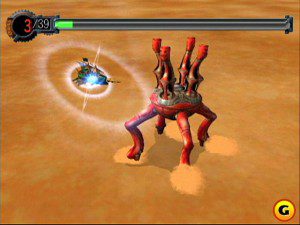
But graphics are only part of the picture. Where Skies of Arcadia shone even more was in the gameplay. It was, in a word, simple. Simple, but also refined to a point where simplicity didn’t mean easy. Skies could best be described as very “stripped down” mechanics wise. No tactical placement needed, magic consumed only 1 MP each cast (2 if it was a powerful spell), combat was a seamless platform of attack, defend, item, retreat. But it also required the player to think. Blitzing all out for the victory might work sometimes, but at others, strategic uses of defense would ultimately make more sense. Each character had “charge” attacks that required the accumulation of turns building up a meter that could then be unleashed to devastating effect. Later in the game, this also allowed for full party special attacks that could end combat in a turn, provided the player was willing (or able) to endure turn after turn of pounding before the combo could be unleashed.
And combat was a big part of the game. Skies had such a high rate of random encounter that it was feasible to enter battle every 4-5 steps. Yes, steps. Fortunately, the Dreamcast gave us a bit of warning, in the form of the disc suddenly stopping, then speeding up rapidly, announcing that we were about to get into it yet again. This high rate of battle was a bit annoying in dungeons, especially if time was a factor, but it also led to a lot of XP, money and drops that would benefit the players later on.
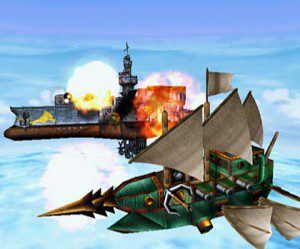 In addition to complex dungeons and unique zones, Skies of Arcadia also showed us that the sky truly was the limit. The world the game takes place on was more a collection of floating islands, joined together by sky ships that were necessary to traverse the immense expanse. Flying through the world, both above and below the clouds, introduced two wonderful new features to the game: exploration and sky battles.
In addition to complex dungeons and unique zones, Skies of Arcadia also showed us that the sky truly was the limit. The world the game takes place on was more a collection of floating islands, joined together by sky ships that were necessary to traverse the immense expanse. Flying through the world, both above and below the clouds, introduced two wonderful new features to the game: exploration and sky battles.
Sky battles were one of the ways Skies managed to distinguish itself from other RPGs of similar style. You would encounter a ship while flying across the expanse, and suddenly it was on, with cannons firing, harpoons launching and magic being throw from bow to stern. These battles were a good deal more technical than the ground fights. Maneuvering was an issue, you had to keep within range or risk missing your shot. And since the ship’s weapons were so powerful, missing a shot then being hit in turn was a devastating blow, especially early on. Of course, you could just harpoon the enemy ship and drag it close, but then it turned into a battle of attrition, with each side punishing the other until one sank.
But sky battles were often necessary to upgrade your ship, earn gold and weapons, and prepare for battles later against bigger, more powerful craft. And of course, against the Gigas. Every single Gigas battle in the game was ship combat, with the first being downright scary to behold. They required you to think instead of blitz, and the careful execution of strategy would be rewarded in the end. All this led up to the final battle against…well, no spoiling here, but the first half of the fight was a giant sky battle that tested every skill the player had acquired up to that point.
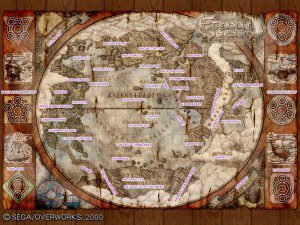 The other joy of flying the “Skies” came in the form of exploring for hidden relics and monuments. While I can’t list all of them here, they represented “bragging” rights both in and out of game, and helped you recruit more members for your Pirate crew. Fly above the clouds, fly below them, scan the islands that appeared empty, who knows what you might find. And these discoveries even had an impact on gameplay: certain potential crew members required you to have found certain things or they wouldn’t join with you. Oh did, I not mention you get a pirate crew? Hmmm, perhaps I should rectify…
The other joy of flying the “Skies” came in the form of exploring for hidden relics and monuments. While I can’t list all of them here, they represented “bragging” rights both in and out of game, and helped you recruit more members for your Pirate crew. Fly above the clouds, fly below them, scan the islands that appeared empty, who knows what you might find. And these discoveries even had an impact on gameplay: certain potential crew members required you to have found certain things or they wouldn’t join with you. Oh did, I not mention you get a pirate crew? Hmmm, perhaps I should rectify…
Over the course of the game, you obtain a small island of your own, which eventually turns into your base. At first, its little more than a lake, cave and some wood for building a house. But remember how I said you get a crew? Well, as you add more and more crew members to your ship, your little island gets bigger and bigger, with more buildings, shops and other facilities that you can use to further enhance your party. The joy of getting more crew parallels the joy of finding more relics, and by the end of the game…well, let’s just say a large crew can inflict a lot of damage in certain situations, where they might be called on to save their captain’s skin.
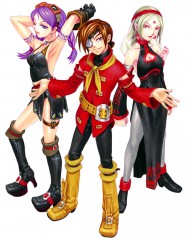
While this game came and went on the short-lived Dreamcast, it was also one of the few that managed to get a second life on the Gamecube a few years later. Skies of Arcadia Legends, a full port of the original game, managed to “correct” a few of the “flaws” in the original game, through a stripping down of the random encounter rate, additions of even more crew and monuments, and wanted battles, which tested your resolve with extremely challenging fights against wicked pirates, imperial spies…and yourselves. That’s right, at one point you get to fight your own “clones” in a knock down, drag out brawl that ends with you being rewarded with…a fish? Yes, it was indeed a fish. But one hell of a fish.
Seeing that both the Dreamcast and Gamecube have faded away into the sunset, finding a copy of this game might be a slight challenge, but it is a worthy addition to the collections of any RPG enthusiast. In an era when Final Fantasy was the standard bearer for what an RPG should be, Skies of Arcadia was something fresh and new, not a copy of what had come before. With freedom to explore, a colorful cast and varied encounters, it gave an experience that has yet to be matched by any contemporary game.


Skies of Arcadia is my favorite game, ever.
And I’m sorry, but I have to point out your omission of Gilder, the other awesome pirate who rotates in their team.
I always forget Gilder, mostly because I never use him. I was always partial to Enrique.
Loved this game still have it for dreamcast and gamecube
Completely agree with this. Skies is still one of my favorite games ever and every time I play through I never get bored.
i have the game on gamecube and i played as drachma since he deals MASSIVE damage …. oh ya all my chars r lvl99 except for gilder and enrique
“Skies had such a high rate of random encounter that it was feasible to enter battle every 4-5 steps. Yes, steps.”
Uh, no, it really didn’t. I know lots of people say that, but it’s false. Really it is.
I replayed it recently, and during the first segment, from the very beginning point of the game until the pirates home island, I only got into 2 battles… and that’s while I was zigzagging to find the hidden stuff along the way!
From home island to first dungeon, also I barely got into any fights.
And during the first dungeons, while exploring on foot, I usually was able to walk for over a full minute before a fight was triggered.
People keep saying this game has too many battles, but it’s completely false. And I’m talking about the Dreamcast version, not the GC one where they supposedly reduced the number of battles.
I really wish people would stop lying about the battles of this game. This game truly deserves to be a treasured classic in everyone’s collection, but the lies about random battles might unfortunately turn people off from even trying it.